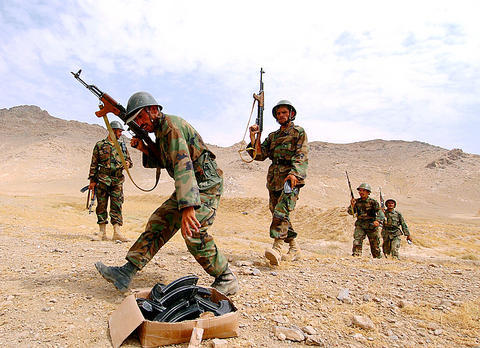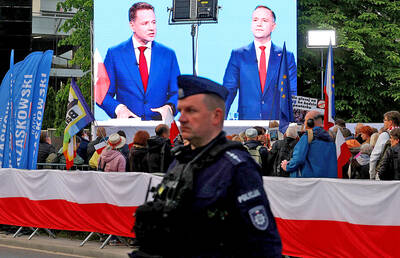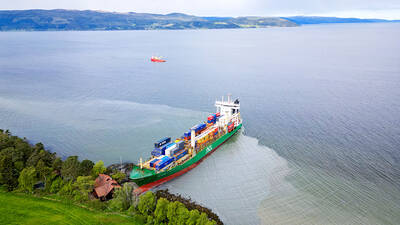Covered in dust and sweating in the unforgiving midday heat, Afghan soldier Rahimullah and his fellow troopers practice shooting at a wooden dummy at a military training ground in Kabul.
Rahimullah, a skinny man in his late 20s, is completing his last day of a program he started about three months ago at the US-funded Kabul Military Training Centre (KMTC).
His high-intensity course has consisted of strenuous drills overseen by Western instructors covering weapons use, tracking an enemy and evacuating a fallen comrade from the battlefield.

PHOTO: AFP
"It has been very difficult to train every day from early morning to late day. But you've got to do it," he said. "I joined the army to defend my country."
With the three-month crash course in warfare under their belts, Rahimullah's class of about 800 soldiers will soon be on remote frontlines where men trained just like they were are already fighting a bloody Taliban-led insurgency.
"They will be deployed across the country," said one of the top Afghan commanders at KMTC, Colonel Mohammad Amin Wahidi.
They will also be the newest members of an army that had to be built from the ground up and on which rests the hopes for the future security of volatile Afghanistan.
When a US-led invasion drove out the extremist Taliban regime in late 2001, no real army, air force or police remained in this vast nation of between 25 million and 30 million people.
The civil war that preceded the Taliban's 1996 takeover had destroyed an army that the Soviet-backed communist occupiers of the 1980s had inherited and expanded to a reported 200,000 soldiers, including a proud air force.
Today, as the international community struggles to help rebuild Afghanistan, the new Afghan National Army numbers over 50,000.
Kabul and its partners on which it depends for money and military support agreed in 2001 that the force should reach 70,000 -- including a 4,000-strong air force -- by the end of next year.
This plan is on track, defense ministry spokesman General Mohammad Zahir Azimi said. But this number will not be enough to allow the Afghans to tackle a growing Taliban insurgency without help, he said.
"When the international community decided on the 70,000 figure, they were not predicting the situation would turn as bad as it is now," Azimi said, adding the future Afghan army should be at least double the planned size.
Insurgency-linked violence has jumped every passing year since 2001 and has claimed more than 5,000 lives this year alone, an AFP count showed -- though most of the dead have been rebels. Last year's toll was about 4,000.
"As we were growing, the Taliban were also growing," Azimi said, accusing "foreign elements," notably from Pakistan, of helping the Islamic rebels, who may have as many as several thousand fighters.
"We are 100 percent reliant on foreign forces," the spokesman said.
He predicts the young army will be dependent for years to come as it develops several branches, perhaps the most difficult being the air force, for which he said the US has promised 200 planes including fighter jets.
The NATO and US-led forces -- which together have about 55,000 soldiers in Afghanistan -- are keen to hand security responsibilities to the Afghans as soon as possible, some hoping by 2011.
For many of the around 40 contributing nations, their presence is politically sensitive and seen as costly -- financially and in terms of human life with every foreign soldier killed feeding concern at home.
NATO believes security is "ultimately going to be provided by the people and the institutions of Afghanistan, not exclusively or solely by international forces," spokesman Nicolas Lunt said at a recent press conference.
"I don't know how many times we, the internationals, need to say this to be heard and understood," Lunt told reporters.
Building the army to a certain strength does not mean it will have the capability to conduct operations independently, General Dan McNeill, the top international commander in Afghanistan, said last week.
"As early as next year we may see certain Afghan units that look fairly independent," he said. "I think it will come in increments. I wouldn't offer a guess as to how many years it will take."
"We have got new weapons, new vehicles and artillery and mortars. That helps us to build the army's capacity. But the problem is with the numbers," Azimi said.
A few years ago, nearly a third of recruits were deserting, but this has changed after huge injections of US cash boosted the monthly pay for a foot soldier to US$100 from under US$60, Wahidi said.
"Back in 2004 and 2005 the desertion rate was very high, sometimes up to 20, 30 percent. But now it's between five and 10 percent," the KMTC commander said.
Back at the training ground, the new soldiers are looking beyond graduation.
"I haven't fought before," said Noor Mohammad, aged about 30.
When asked if he was scared of Taliban rebels, he stammered: "I don't know, maybe ... maybe yeah."
Allah Mohammad, of a similar age, said he was ready to take on the rebels.
"I'm not scared, they should be scared of me," the proud soldier said with a laugh.

Polish presidential candidates offered different visions of Poland and its relations with Ukraine in a televised debate ahead of next week’s run-off, which remains on a knife-edge. During a head-to-head debate lasting two hours, centrist Warsaw Mayor Rafal Trzaskowski, from Polish Prime Minister Donald Tusk’s governing pro-European coalition, faced the Eurosceptic historian Karol Nawrocki, backed by the right-wing populist Law and Justice party (PiS). The two candidates, who qualified for the second round after coming in the top two places in the first vote on Sunday last week, clashed over Poland’s relations with Ukraine, EU policy and the track records of their

UNSCHEDULED VISIT: ‘It’s a very bulky new neighbor, but it will soon go away,’ said Johan Helberg of the 135m container ship that run aground near his house A man in Norway awoke early on Thursday to discover a huge container ship had run aground a stone’s throw from his fjord-side house — and he had slept through the commotion. For an as-yet unknown reason, the 135m NCL Salten sailed up onto shore just meters from Johan Helberg’s house in a fjord near Trondheim in central Norway. Helberg only discovered the unexpected visitor when a panicked neighbor who had rung his doorbell repeatedly to no avail gave up and called him on the phone. “The doorbell rang at a time of day when I don’t like to open,” Helberg told television

‘A THREAT’: Guyanese President Irfan Ali called on Venezuela to follow international court rulings over the region, whose border Guyana says was ratified back in 1899 Misael Zapara said he would vote in Venezuela’s first elections yesterday for the territory of Essequibo, despite living more than 100km away from the oil-rich Guyana-administered region. Both countries lay claim to Essequibo, which makes up two-thirds of Guyana’s territory and is home to 125,000 of its 800,000 citizens. Guyana has administered the region for decades. The centuries-old dispute has intensified since ExxonMobil discovered massive offshore oil deposits a decade ago, giving Guyana the largest crude oil reserves per capita in the world. Venezuela would elect a governor, eight National Assembly deputies and regional councilors in a newly created constituency for the 160,000

North Korea has detained another official over last week’s failed launch of a warship, which damaged the naval destroyer, state media reported yesterday. Pyongyang announced “a serious accident” at Wednesday last week’s launch ceremony, which crushed sections of the bottom of the new destroyer. North Korean leader Kim Jong-un called the mishap a “criminal act caused by absolute carelessness.” Ri Hyong-son, vice department director of the Munitions Industry Department of the Party Central Committee, was summoned and detained on Sunday, the Korean Central News Agency (KCNA) reported. He was “greatly responsible for the occurrence of the serious accident,” it said. Ri is the fourth person